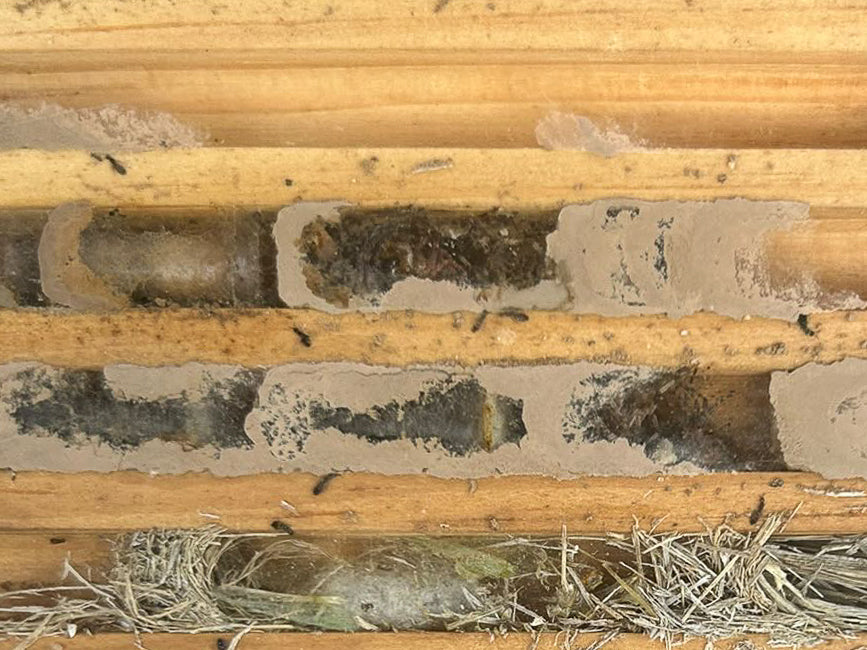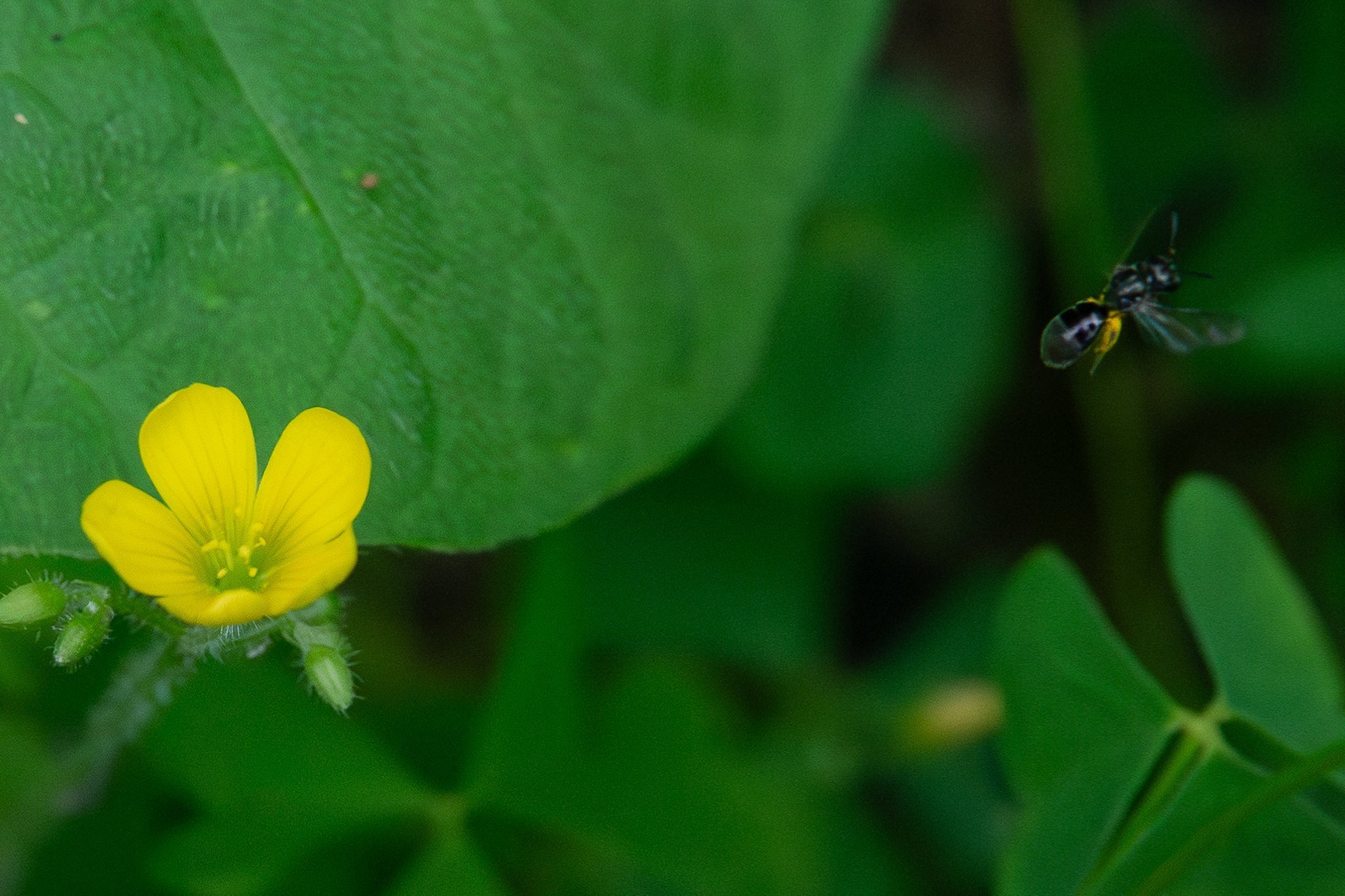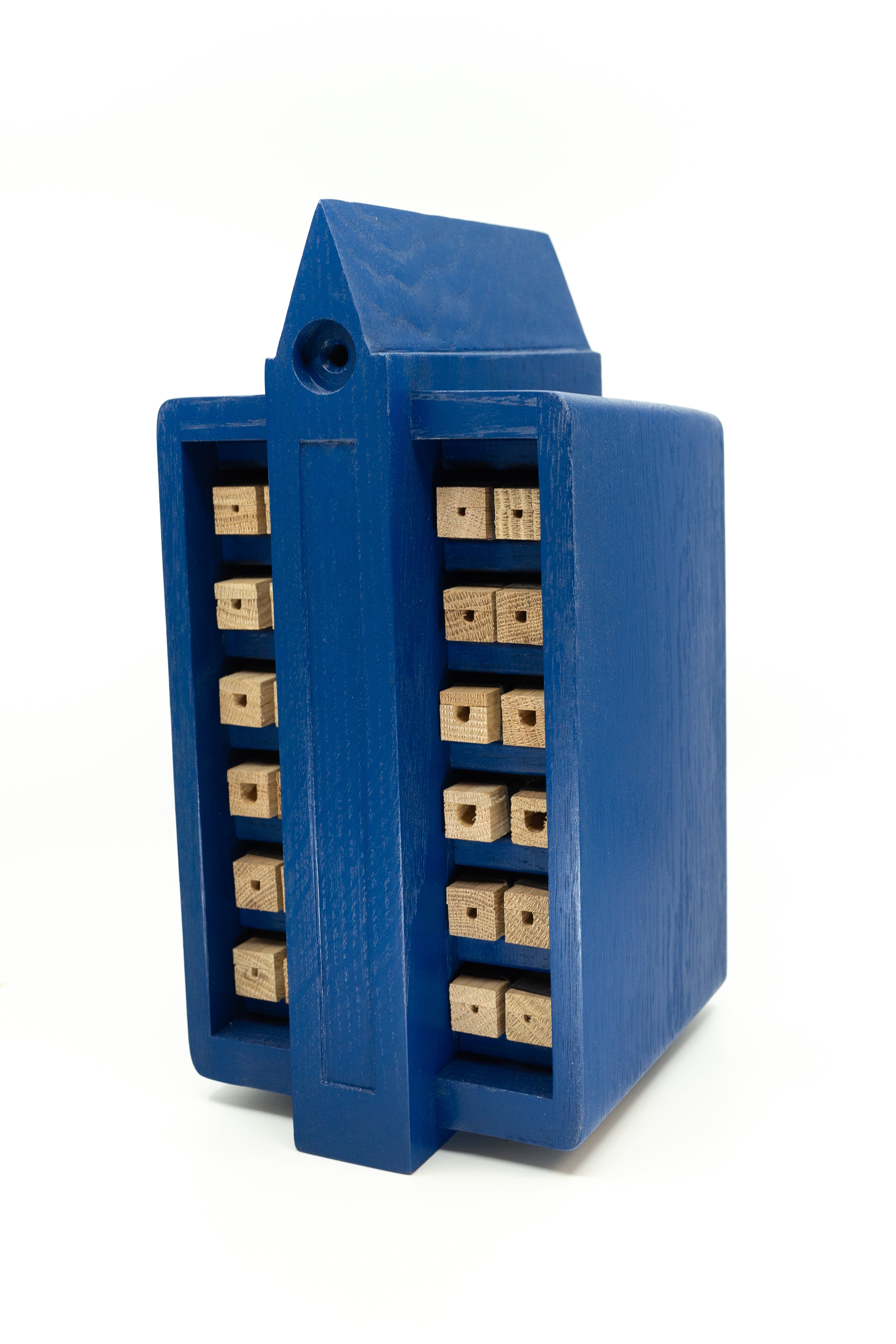By Dr. Jessica Forrest and Ryan Brideau
A customer sent us a photo this week that really underscored the importance of how solitary bee nesting sites are designed. She had been using a different brand of bee hotel for a few years, but had concerns over some things she was seeing. (I won't name the brand because it's not important - this issue is present in many common designs.) In particular, the most concerning issue was these little black creatures that seemed to be crawling between the plexiglass and the wooden nesting tray:

At first, the customer thought these were mites, but after she sent us some closer photos, Jessica identified them as being either pteromalids or Melittobia - very small parasitic wasps. Melittobia, for example, are between 1 and 1.5 mm and can fit into very small cracks. They are common invaders of bee and wasp nests, where they feed on the tissues of the developing brood. Because they breed quickly and can chew through cocoons and the walls separating brood cells, they can kill all other nest occupants. They aren't great fliers, but they will readily move from one nest to another by crawling.

If you look closely at the first photo above, you'll notice something very concerning: these wasps may have started in one of the nesting chambers, but because the design of the bee hotel didn't account for the flex in the acrylic and the warping of the wood, a small gap formed along the entire width of the nesting tray. These wasps could then travel between all the nests freely, and left unchecked, would kill most things they came across.
In fact, you can actually see evidence in the same photo that the mother wasp that built the nest out of mud in the upper chambers anticipated this, and tried to fill in the gaps along the edge of the cell - a somewhat unusual behaviour, as they typically only use mud to divide cells. Highlighted below is an example. Unfortunately, she didn't do this to all the cells, and left gaps that the parasites could easily enter.

What Makes a Good Design?
Nature is a good teacher, and we can learn a lot from the natural locations that cavity nesting bees and wasps choose to inhabit. In particular, some of the most common sites are beetle holes in dead wood. These holes have some important properties, and we'll get into detail about why each of these is important, and how Scopa's nesting blocks and homes are designed with these in mind:
- There is typically only one way in, through the front entrance
- Each hole is surrounded by thick wooden walls
- The holes are often isolated from each other
- They aren't densely packed together
Only a Front Entrance
Some nesting blocks will put the holes all the way through the wood so that it's open at both the front and the back. Or, material like bamboo shoots are used and are left open at both ends. This is a problem because when the mother bee builds her nest, the back will often not be plugged up to the same level as the final thick cap she puts on the front.
This final front cap is meant to be a thick barrier that can't be easily broken through by predators, kind of like the gigantic granite portcullis stones used by the ancient Egyptians to seal off parts of the pyramids. Once they're put in place, there should be no way in.
If the back is left open, however, there is a way in, and parasites will find it and inevitably take over the nest. If there is also a high density of nests, they can use these rear entries to move between them, similar to how the parasites above moved between nests via the gap in the side, and reproduce quickly.

To address these concerns, we use a stopped dado for each of our nesting blocks. This is a fancy way of saying a "groove that doesn't go all the way through the wood", leaving about a quarter of an inch of wood at the rear so that it's well protected. We also pre-split our blocks for easy cleaning, but hold them together tightly with UV-resistant bands so that no cracks are present to let parasites in from the sides. All our viewing windows are pressure-fit into the blocks, and leave no gaps for entry.
Thick Walls
Having lots of material between the cavity and the outside is also important for protection again parasites. If you use thin nesting material, and it develops cracks - as almost all thin wood will when outdoors - it becomes very easy for parasites like Leucospis to stick their ovipositor into the cracks and lay their eggs into the nesting material.

Some parasites can even push their ovipositor through soft woods without cracks, and through thin bamboo or paper straws. If you use a soft wood, make sure there is lots of it between the nesting site and the outside. And if you use straws or bamboo, it's best to fit them snugly into a larger wooden block for protection, and make sure there is no gap between their sides and the block.
To address this issue, we use white oak for all of our nesting blocks. It's very dense, making it impossible for most ovipositors to puncture, and we keep the walls thick to prevent any surface cracks from reaching the nests.
Isolated Nests
As we saw above, having a way for parasites to bypass the outer cap that the mother bee creates, and thereby move between nests, is a big problem. This is an issue for almost any design that uses large wooden trays with a removable top, unless the builders have gone out of their way to ensure there are no gaps between the grooves.

With our blocks, we sidestep this problem entirely by making each nesting block individually, and ensuring each block itself is well protected. While it's still possible for a single block to get parasitized, this significantly reduces the chances of parasites spreading between nests. And if you notice that a block has parasites, you can easily remove it from the bee home to further reduce the chances of spread. It also comes with the added benefit that you can swap out blocks as they are finished, and adapt the range of hole sizes to your local species, and through the season.

Nest Density
While some cavity nesting species will live in close proximity, the density of those nests is far from the "wall of nesting sites" you see in some bee hotel designs. Whenever you house any animal in high concentration, it introduces problems that need to be carefully monitored and managed. Unless you're using wild bees for large agricultural applications, we recommend keeping the number of nesting sites at any location to no more than a dozen or so, with a range of hole sizes for different species to avoid concentrating too many of one type.

With our homes, we intentionally keep the number of blocks low. That way, in the worst case scenario of somehow every block becoming parasitized, it still would not have an outsized impact on the population of bees and wasps in your yard. We also include nesting cavities ranging from 1/16" in diameter up to 5/16" so that different species will be present in the same home. Most parasites (other than Melittobia) will only attack a single type of host, so having a diverse set of species using the home minimizes the chances of parasites being attracted to the home or spreading from nest to nest.
What if You Want to Make Your Own Bee Habitat?
We have taken the approach we have because we wanted to address all of these issues, while still making it easy to view the contents of each of these blocks for educational purposes, and to make them easy to maintain. However, they aren't simple to make, and it's taken us a long time to get the process perfected.

If viewing what's inside isn't that important to you, and you're OK with some other insects or arachnids getting in and being hard to evict, there's a simple design that addresses all of these concerns: take a log or piece of wood and drill a handful of holes in the end using long (5"+) drill bits of different sizes from about 1/8" up to 5/16". (You can use a shorter bit for the 1/8" holes, as the species that live there are much smaller.") You'll then have nesting sites that have only one entrance, are protected by thick side-walls, and are isolated from one another. You may find that cracks eventually form around the holes, but you can fill these with wood glue and sawdust or wood filler. While you won't be able to see what's going on inside, you can sleep soundly knowing that the bees and wasps in your yard have a healthy habitat to live in.





Join Our Newsletter
Share:
How to Keep Earwigs, Ants and Spiders Out of Your Bee Hotel
What To Do When Your Bee Blocks Fill Up (And How to Make a Simple Release Box)